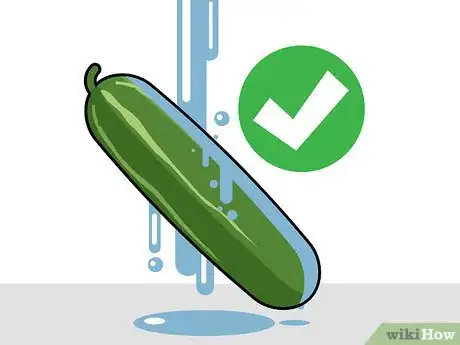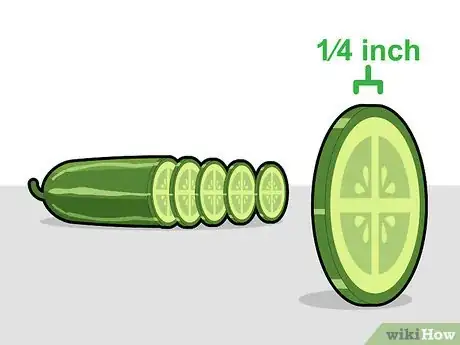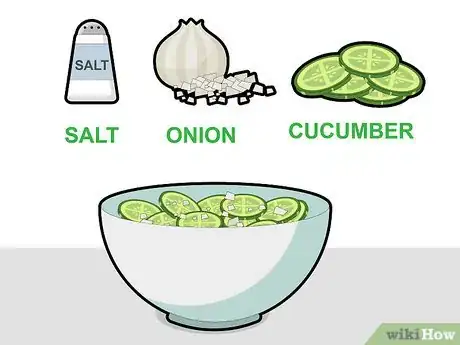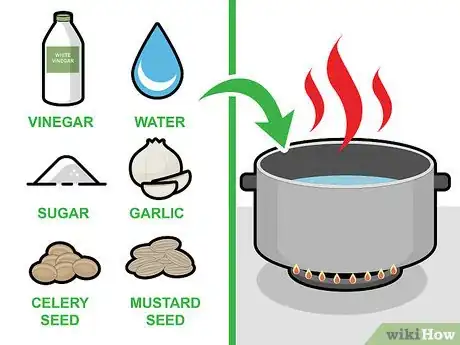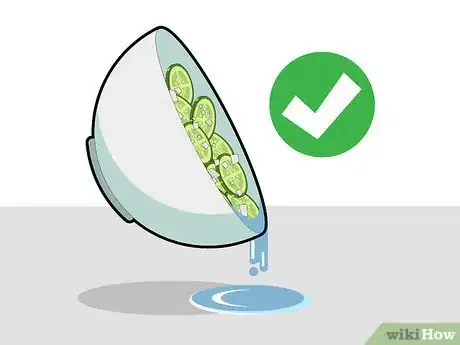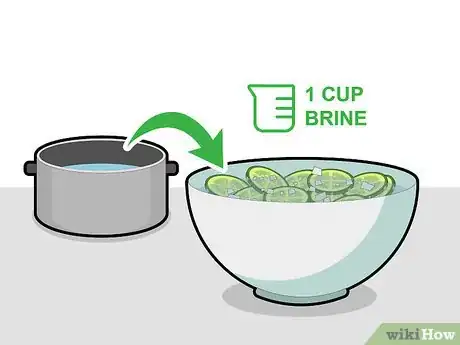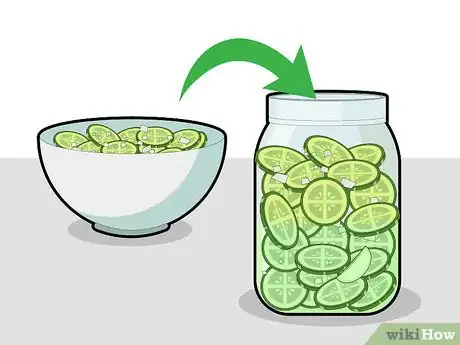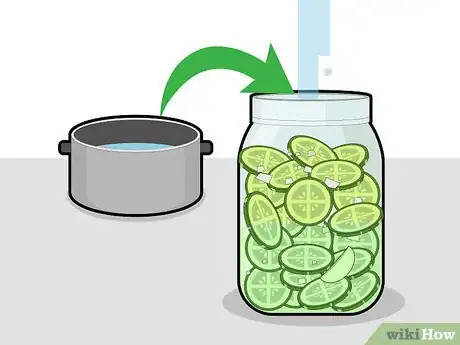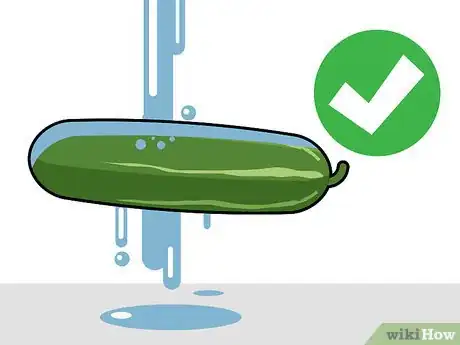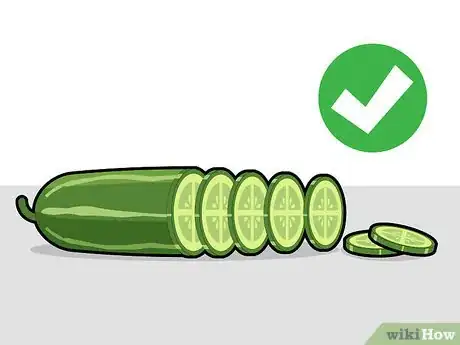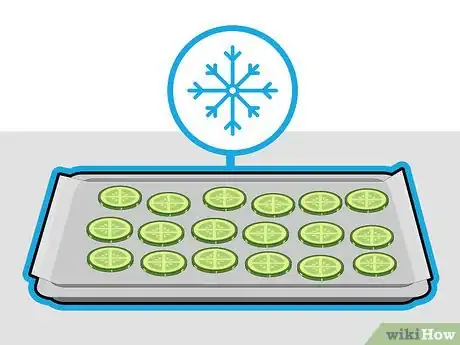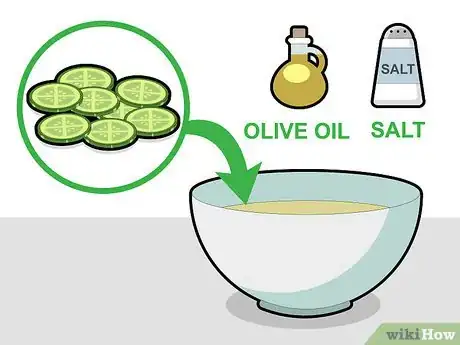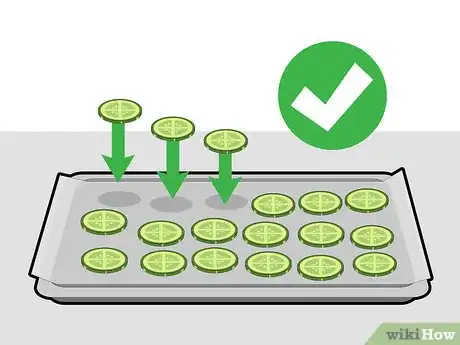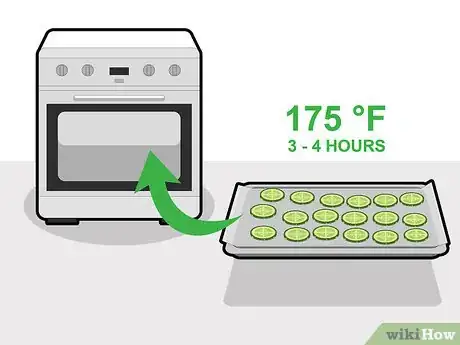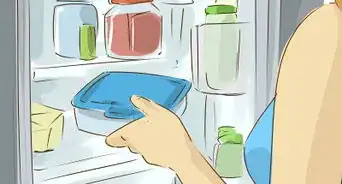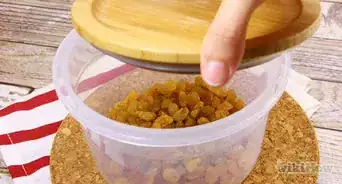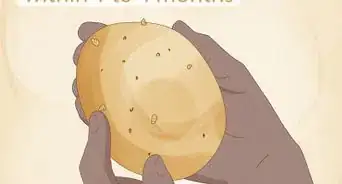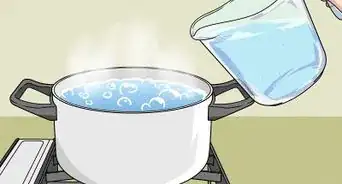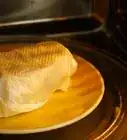This article was co-authored by wikiHow Staff. Our trained team of editors and researchers validate articles for accuracy and comprehensiveness. wikiHow's Content Management Team carefully monitors the work from our editorial staff to ensure that each article is backed by trusted research and meets our high quality standards.
There are 7 references cited in this article, which can be found at the bottom of the page.
This article has been viewed 20,310 times.
Learn more...
Cucumbers are a staple in most households, going in salads and infusing water. Sometimes, though, you're left with quite a few cucumbers that you're not sure what to do with.[1] Instead of wasting them, there are a few ways you can preserve your cucumbers so you can enjoy them for weeks to come.
Steps
Making Refrigerator Pickles
-
1Wash the cucumbers. Washing gets the excess dirt and chemicals off, a necessary step even if you’re growing your own vegetables. Chemicals can still seep into the dirt and water supply, getting onto your vegetables.[2]
- You don’t need a special vegetable soap. Tap water gets rid of 98% of the chemicals and bacteria on vegetables. If you’re concerned about your tap water quality, use distilled water to wash your vegetables.[3]
-
2Slice your cucumbers. How thin you cut them is based on your pickle preference, but keeping them about 1⁄4 inch (0.64 cm) should be fine.[4]
- Use a mandoline to keep the thickness even. An even thickness allows for the taste to be more uniform.
Advertisement -
3Mix cucumbers, salt, and onion in a large bowl. Toss the ingredients to combine them completely. Make sure the cucumbers and onions are covered in the salt.
- Cover the bowl and let the cucumber onion mixture sit for an hour.[5]
-
4Combine vinegar, water, sugar, garlic, celery seed, and mustard. In a pot, mix the ingredients together to make the brine. You will have about 2 cups (470 mL) of brine.[6]
- Set the pot on the stove and bring the mixture to a boil, stirring occasionally.
- Boil for around two minutes or until the sugar has dissolved.[7]
-
5Drain the excess liquid from the cucumber onion mixture. Cucumbers are full of water, so there will be water collected at the bottom of your cucumber and onion mixture. You don't want that in your pickling jars. Pour the remaining liquid out, being careful not to drop any of the cucumbers out of the bowl.[8]
- You can use a strainer with smaller netting. That will keep the onion and cucumbers from falling out with the excess liquid.
-
6Pour half the brine, or about 1 cup (240 mL), over the cucumbers. Save half of the brine to pour into the jars later. Stir gently to combine everything.[9]
- You want to be gentle when stirring so you don’t break any of the cucumbers.
- Cover and let it sit for 10 minutes.
-
7Fill your jars with the cucumbers. Carefully scoop the cucumbers into the jars, making sure you don't break the cucumbers. You can use large serving spoon to scoop the cucumbers out.
- Make sure each jar has at least one piece of garlic in it.[10]
-
8
-
9Place the jars in the fridge. Allow the jars to cool, and then put them in the fridge for at least 24 hours.
- The cucumbers will be good for up to 8 weeks.[13]
Freezing Cucumbers
-
1Wash the cucumbers. Whether you bought your cucumbers at a store or grew them in your own garden, your cucumbers are still going to need to be washed. Chemicals from the environment, such as arsenic and lead, can still seep into the soil you’re growing your vegetables in. Cleaning off your vegetables reduces what chemicals get into your food.[14]
- There is no need to use special vegetable soaps or washes. Your tap water will get 98% of the bacteria and chemicals off your vegetables. If you’re concerned about your tap water quality, though, you can always use distilled water to wash your vegetables.[15]
-
2Slice the cucumbers. You can slice them anyway you want. If you want to infuse water with the frozen cucumbers, then slice them in a way that’s going to fit your water bottle or pitcher.
- If you are planning on putting the cucumbers into smoothies or making dip out of them, freeze the cucumbers whole. Put them in an airtight container to make sure they don't get freezer burn.[16]
-
3Place the cucumber slices on a baking sheet. This will make sure they freeze evenly. If you just put them in a zippered freezer bag, then the cucumbers slices will freeze clumped together.
- You can line the baking sheet with parchment paper to make it easier to remove the cucumbers when frozen.
- Once frozen, you can move the slices to a zippered freezer bag for easy storage.
- Frozen cucumbers can be used to infuse water, make dips, and make smoothies.[17]
Making Cucumber Chips
-
1Slice the cucumbers. How thin you slice the cucumbers is based on your preference, but you usually want to make sure they are very thin. Try to keep the thickness uniform; this will allow the cooking time to remain consistent.[18]
- If you are planning to bake the chips on an aluminum foil lined baking sheet instead of a parchment paper lined baking sheet, then make the cucumber slices slightly thicker.
- Use a mandoline slicer to make sure your cucumbers are sliced to a uniform thickness.[19] If you don’t have a mandoline, you can eyeball it.
-
2Remove excess moisture. Placing a paper toil over the cucumbers, lightly press down to remove moisture.[20]
- Excess moisture will cause the cucumbers to take longer to cook.
-
3Toss the cucumbers in salt and olive oil or avocado oil. If it looks like not all the cucumbers are getting oil, you can add a bit more.[21]
- You can use either olive or avocado oil, but they each have a different flavor to them that can influence the flavor of the chip. It is up to you to decide which flavor you would prefer.
-
4Line baking sheet with parchment paper. Then lay the cucumbers down on the baking sheet. Do not let the cucumbers touch. They will end up sticking together.[22]
-
5Bake at 175 °F (79 °C) 3-4 hours. Keep an eye on the cucumbers, checking to make sure the edges aren’t burning or turning black.[25]
- Each oven cooks differently and cooking times will vary.
- You can also put the cucumbers in a dehydrator. Dehydrate them at 135 °F (57 °C) for 4-6 hours, or until they are dry and crisp.[26]
Things You'll Need
Making Refrigerator Pickles
- 2 pounds (0.91 kg) of cucumbers
- 3 tsp salt
- .75 cups (180 mL) of chopped onions
- 1 cup (240 mL) of white vinegar
- .5 cups (120 mL) of water
- 1.5 cups (350 mL) of sugar
- 1 tbsp of celery seed
- 1 tbsp of mustard seed
- 3-6 Cloves of garlic-- peeled, bruised, and halved
Freezing Cucumbers
- Cucumbers (however many you want to freeze)
- Parchment paper (if you’re cutting the cucumbers)
- Baking sheet (if you’re cutting the cucumbers)
- Zippered freezer bag (if you're cutting the cucumbers)
- Airtight container (if you’re freezing them whole)
Making Cucumber Chips
- 2 Medium cucumbers or 3 small ones
- Oven or dehydrator
- 1 tbsp of olive oil or avocado oil
- 1 tsp salt
- Different seasonings depending on what flavor you want
References
- ↑ https://thefreerangelife.com/preserve-cucumbers/
- ↑ https://gardenroots.arizona.edu/sites/gardenroots.arizona.edu/files/pdf/practices_for_safe_veg_consumption.pdf
- ↑ https://modernfarmer.com/2015/01/7-myths-washing-produce/
- ↑ https://thefreerangelife.com/easy-refrigerator-pickles/
- ↑ https://thefreerangelife.com/easy-refrigerator-pickles/
- ↑ https://thefreerangelife.com/easy-refrigerator-pickles/
- ↑ https://thefreerangelife.com/easy-refrigerator-pickles/
- ↑ https://thefreerangelife.com/easy-refrigerator-pickles/
- ↑ https://thefreerangelife.com/easy-refrigerator-pickles/
- ↑ https://thefreerangelife.com/easy-refrigerator-pickles/
- ↑ https://thefreerangelife.com/easy-refrigerator-pickles/
- ↑ https://thefreerangelife.com/easy-refrigerator-pickles/
- ↑ https://thefreerangelife.com/easy-refrigerator-pickles/
- ↑ https://gardenroots.arizona.edu/sites/gardenroots.arizona.edu/files/pdf/practices_for_safe_veg_consumption.pdf
- ↑ https://modernfarmer.com/2015/01/7-myths-washing-produce/
- ↑ https://www.green-talk.com/freeze-cucumbers-learn-how-to-use-them/
- ↑ https://www.green-talk.com/freeze-cucumbers-learn-how-to-use-them/
- ↑ https://thefreerangelife.com/cucumber-chips/
- ↑ https://thefreerangelife.com/cucumber-chips/
- ↑ https://lowcarbyum.com/baked-cucumber-chips/
- ↑ https://lowcarbyum.com/baked-cucumber-chips/
- ↑ https://thefreerangelife.com/cucumber-chips/
- ↑ https://lowcarbyum.com/baked-cucumber-chips/
- ↑ https://thefreerangelife.com/cucumber-chips/
- ↑ https://lowcarbyum.com/baked-cucumber-chips/
- ↑ https://thefreerangelife.com/cucumber-chips/
